BE400 Infections in Medical Devices Final
1/464
There's no tags or description
Looks like no tags are added yet.
Name | Mastery | Learn | Test | Matching | Spaced |
|---|
No study sessions yet.
465 Terms
Binomial nomenclature
two word naming system
genus (capitalized) + species “specific epithet”
Strains
subtypes of one species of microorganism
ex. Staphylococcus epidermis 0594
microbes are generally
unicellular and not visible to the naked eye
How big must an object be to be visible without magnification?
~100 micrometers
Which domains are microorganisms found in?
All three: Archaea, Bacteria, and Eukarya
What do prokaryotic microorganisms lack?
a nucleus and other organelles
Bacteria characteristics
single-celled organism (unicellular)
can be harmless or pathogenic (disease-causing)
most cell walls contain peptidoglycan
many in human flora, and can be pathogenic
Acute infections
conditions that begin suddenly and is often short-lived
rapid onset of symptoms
Examples of acute infections
influenza, UTI
Chronic infections
Condition that develops gradually and persists over time
symptoms develop slowly and are slow to resolve
Chronic infection examples
Hepatitis B and C
lyme disease
Subacute infections
symptoms develop more slowly than acute, but faster than chronic
What is the initial site of infection from which organisms spread called?
focal
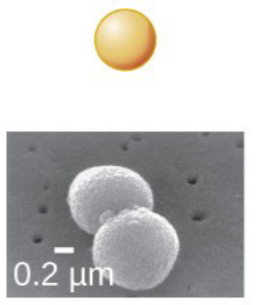
What type of bacteria is this?
coccus
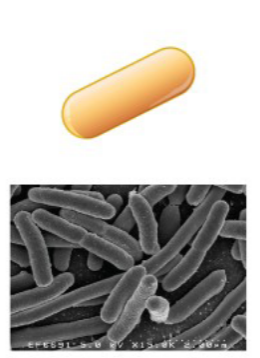
What type of bacteria is this?
bacillus
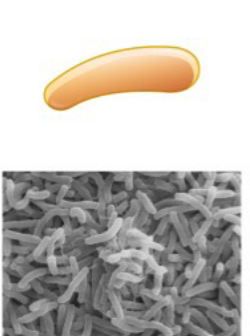
What type of bacteria is this?
Vibrio
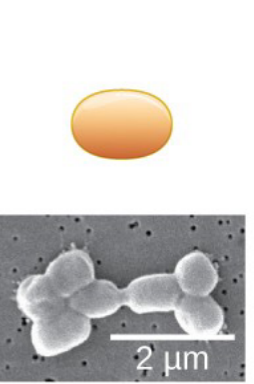
What type of bacteria is this?
coccobacillus
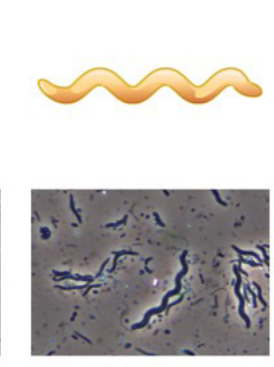
What type of bacteria is this?
Spirillum
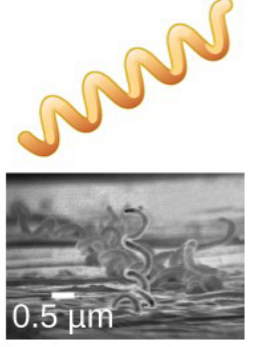
What type of bacteria is this?
spirochete
Bacteria general definition
described by general shape (cell morphology)
wide range of metabolic capabilities and can grow in many different environments
anaerobic and aerobic
What does the bacterial cell wall do?
morphology is maintained by cell wall
protects cell from changes in osmotic pressure
isotonic solution
no net movement of water particles
cell membrane is attached to the cell wall
hypertonic solution
water particles move out of the cell
cell membrane shrinks and detaches from cell wall
plasmolysis
cell membrane shrinks and detaches from cell wall
hypotonic solution
water particles move into the cell
cell wall counteracts osmotic pressure to prevent swelling and lysis
nucleiod
area where chromosomes are in bacterial cells
All cellular life has DNA genome organized into one or more __________
chromosomes
Typical traits of prokaryotic chromosomes
circular
haploid (unpaired/single-stranded)
not bound by a nucleus
Nucleoid associated proteins (NAPs)
interact with DNA to aid organization and chromosomal packaging
What do the proteins on the surface of the plasma membrane do?
cell-to-cell communication
sense environmental conditions and pathogenic virulence
glycoprotein/glycolipid
associated carbohydrates (sugars) that interact with the external environment
types of membrane transport
simple diffusion
facilitated diffusion
active transport
peptidoglycan
only found in bacteria
long chains of alternating molecules
crosslinked heteropolymer of alternating sugars
gives the cell its shape
Crosslinked heteropolymer of alternating sugars in peptidoglycan
N-acetylglucosamine (NAG) and N-acetylmuramic acid (NAM)
NAM and NAG connected by peptide bridges that vary based on type of bacteria
cross-linking happens via transpeptidase
gram-positive bacteria
thick peptidoglycan layer (30-100nm)
teichoic acid
How does teichoic acid contribute to gram-positive bacteria?
pathogenicity
gram-negative bacteria
outer and inner membrane
thin peptidoglycan (<4nm)
lipopolysaccharide (LPS)
How does LPS contribute to gram-negative bacteria?
acts as endotoxin
What color are gram-negative bacteria after staining?
pink
What color are gram-positive bacteria after staining?
dark purple
glycoalyces
additional envelope structures exterior to cell wall
sugar coat
capsule
slime layer
allows cells to adhere to surfaces, aiding in formation of biofilms
glycoalyx capsule
organized layer comprised of polysaccharides or proteins
glycoalyx slime layer
loosely attached layer composed of polysaccharides, glycoproteins, or glycolipids
Fimbriae and pilli
aid in attachment to surfaces
flagella
aids in movement in aqueous environments
binary fission
process by which bacteria asexually reproduces
Doubling time
amount of time it takes for the population to double through one round of binary fission
What is doubling time dependent on?
species and growth environment
lag phase
initial growth on curve
no increase in number of living bacterial cells
log phase
exponential increase in number of living bacterial cells
stationary phase
plateau in number of living bacterial cells
rate of cell division and cell death roughly equal
death/decline phase
cells begin to die
Parameters for growth curve
microorganisms grown in batch culture
no nutrients added or removed
predictable curve
culture density
number of cells per unit volume
can calculate population in fixed volume
virulence
ability of a microorganism to cause disease (pathogenicity)
infection
occurs when a microbe overcomes the defense barriers and lives inside the host
disease
infections that result in damage to the host tissue or disruption of normal function
pathogenecity
ability of microbial agent to cause disease
virulence
degree to which an organism is pathogenic
ID50
infectious dose 50
dose that will infect 50% of a population
LD50
lethal dose 50
dose that will kill 50% of a population
primary pathogen
cause disease in a host regardless of the host’s resident microbiota or immune system
opportunistic pathogen
can only cause disease in situations that compromise the host’s defenses, such as the body’s protective barriers, immune system, or normal microbiota
What most a microbe do first to infect a host?
attach to a specific receptor
no receptor = no attachment
tissue tropism
specificity of microbe to attach to tissue
why a specific infectious disease only involves specific tissue
attachment sites
areas of microbial attachment, may be animal species specific
Examples of attachment sites
pili
specialized surface proteins
metabolism
chemical reactions that occur within a cell
exergonic reactions
spontaneous reactions that release energy
catabolism
break down complex molecules
energy can be stored in bonds of complex molecules that is released to then drive anabolic reactions
Is catabolism exergonic or endergonic?
exergonic
endergonic reactions
require energy
anabolism
converts simple molecules into more complex molecules, fueled by cellular energy
Is anabolism exergonic or endergonic?
endergonic
glycolysis
catabolism of glucose
produces energy (ATP)
produces reduced electron carriers
produces precursor molecules for cellular metabolism
Where does glycolysis take place?
cytoplasm
Krebs cycle products
2 CO2
ATP or GTP
3 NADH
CoA
Energy investment phase of glycolysis
start with glucose and 2 ATP
reaction occurs to yield 2 ADP and fructose diphosphate
fructose becomes 2 glyceraldehyde 3-phosphate
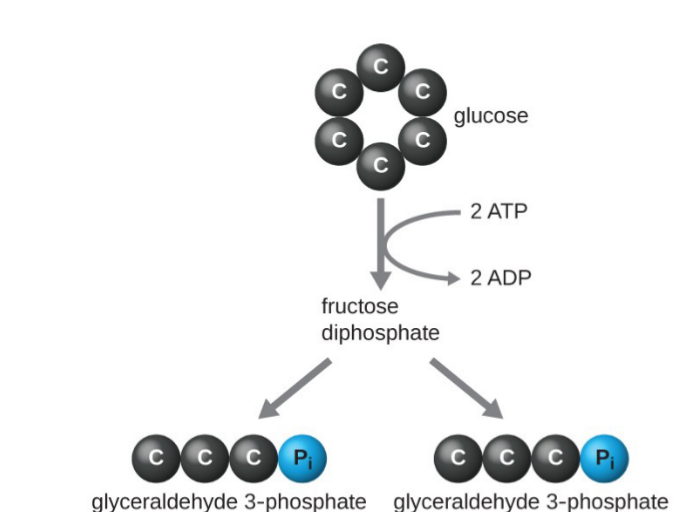
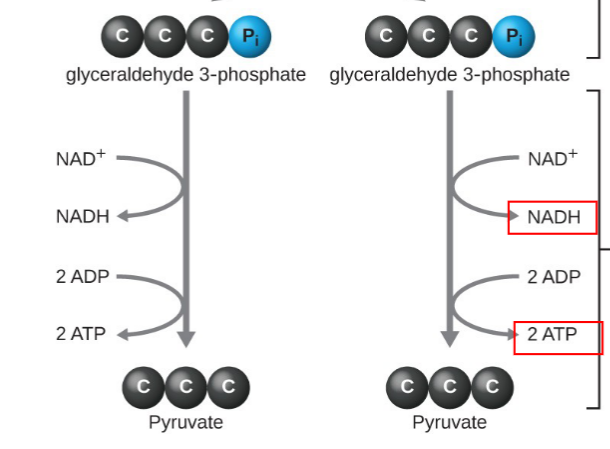
Energy payoff phase of glycolysis
start with 2 glyceraldehyde 3-phosphate
NAD+ reduces to NADH
2 ADP becomes 2 ATP
carbon chains become 2 pyruvate
Products of the breakdown of a single glucose molecule through glycolysis
2 ATP
2 NADH
2 pyruvate molecules
chemiosmosis
flow of hydrogen ions across the membrane
ATP synthase
membrane-bound enzyme complex that channels H-
cellular bioenergetics
ATP is produced from pH and electrostatic charge gradients (and) set across the cytoplasmic membrane
What happens if H+ ions are neutralized by hydroxide ions
the concentration gradient collapses and impairs energy production
How does pH influence proteins and disrupt hydrogen bonding?
alters folding pattern
alters activity
acidophile
thrives in low pH
neutrophile
thrives in neutral environments
alkaliphile
thrives in high pH
What does a pH microbial growth chart show?
optimum growth
maximum growth
minimum growth
pyschrophiles temperature range
-5 to 20 degrees C
mesophiles temperature range
15 to 45 degrees C
thermophiles temperature range
45 to 80 degrees C
hyperthermophiles temperature range
65 to 105 degrees C
States pf bacterial existence
biofilm-associated (sessile) state
persister state
planktonic
bio-film associated (sessile) state
bacteria attach to a surface and become embedded in a self-produced extracellular polymeric matrix (EPS) matrix
this forms a biofilm
this state provides protection from antibiotics, immune responses, and environmental stressors
persister state
subpopulation of bacteria that enters a dormant, non-replicating phase within a biofilm or planktonic culture
these cells are highly tolerant to antibiotics but can evert to an active state when conditions improve
Biofilm formation steps
Formation of conditioning layer
reversible attachment of planktonic cells
first colonizers become irreversibly attached
growth and cell division
production of EPS and formation of water channels
attachment of secondary colonizers and dispersion of microbes to new sites
Amount of time each step in biofilm formation takes
seconds
seconds, minutes
hours, days
hours, days
days, months
Acute inflammation
vasoconstriction to reduce blood loss—brief
vasodilation due to histamine response
increased blood flow dilutes toxins and bacterial products
chronic inflammation
often results in an ongoing lower-level battle between host organism and pathogen
granulomas formed